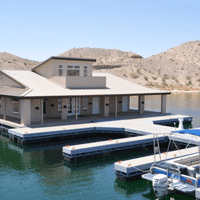Buildings on the water are nothing new, but the new Marina Services Building at Cottonwood Cove Resort & Marina on Nevada’s Lake Mohave is hailed as the first of its kind—the first floating structure submitted for LEED certification. Replacing a decades-old building, and in partnership with the National Park Service, Forever Resorts set out to construct an on-the-water building that showcases green technology. Here, Rod Taylor, regional vice president of Forever Resorts, talks with gb&d about the floating building he expects to be certified LEED Gold later this year.
What prompted you to build a floating LEED-certified structure?
Rod Taylor: We had a windstorm back in 2007 that destroyed the marina and most of the infrastructure. We wanted to build a new state-of-the-art marina with sustainable products. When it came down to designing the building, I thought about a green building on the water. I talked to the Park Service, which is our landlord, and they got excited and got behind it not only because it is the right thing to do, but it would be the first certified LEED structure floating on water.
How much was your budget for this project?
Taylor: We had a fixed amount of $642,000 to work with, and I really wasn’t allowed to go over that. We needed to do something creative to come in on budget, so we designed a flyer and donation forms to send to different companies asking them to help us on cost, either a full donation or to provide discounted goods and services. Much of the materials and labor were given to us for free or at discounted rates, so we had multiple partners helping us stay in budget. Some tweaking was needed toward the end, and Ausonio, our LEED consultant, volunteered a substantial amount of time to get this project finished, as did our engineers and architects. The final project cost was only $4,000 over budget.

Shown is a sample of a typical pre-fabricated wall section with utilities running through it. The foam piece is also used for the subfloor and roof.
What are some of the green elements that contribute LEED credits?
Taylor: Some of the credits that count toward certification were not available to us because there was no site prep on this project. But the energy efficiency of the building is a big component—the roof, walls, and even the floor have an R-value. Another big contributor was the tremendous amount of recycled content of this structure: The steel is 100 percent recycled. The subfloor is recycled nylon carpet pieces. And Premier Materials provided us with decking that’s made out of rice hulls and recycled plastics. Also, the material we recycled off the project was close to 90 percent. We only had one small dumpster of trash at the end of the whole project.
Can you describe some of the challenges you faced during construction?
Taylor: Building the structure on the water had some challenges. We used modified structural insulated panels, which are large, solid foam panels with steel studs inside that are trimmed as they’re erected at the site. But if the wind is blowing, you can’t do anything because the stuff blows into the lake. It’s the desert, so we had a tremendous number of days where we couldn’t work because the wind was blowing. Our assembly was painstakingly long because of the days we couldn’t work.
Is there anything about the building that you’re particularly pleased with?
Taylor: The overall aesthetics have really turned out well, and this building actually reduced the night sky pollution from the old building substantially. We used to have 250-watt sodium vapors with 360-degree, three-dimensional lighting that would light the sky, the ground, everything, and we went to downcast fluorescents. People are now having stargazing events out here, and they can even use their telescopes, so the night sky protection at the end of this project really was enhanced.

